Quick search
⌘+K
Quick search
⌘+K
Koutelos, a tranquil and unstructured beach with large round pebbles, is situated close to the village of Nomikiana. It’s approximately 9km to the east of Chora Sfakion, 4km to the west of Fragokastelo, and 76km to the south of Chania.
If you’re traveling from Sfakia, take the road leading to Fragokastelo. Shortly after passing Vouvas and Nomikiana, turn onto the road leading to the beach. Koutelos is clearly signposted. It’s a place worth visiting if you’re in the area, but it’s not a standalone attraction. It’s best to combine a trip to Fragokastelo with a visit to Koutelos if you’re looking for some peaceful moments or a bite to eat at the local fish tavern.
The beach features a traditional fish tavern where you can also find accommodations in a few adjacent rooms. Additionally, the beach is dotted with tamarisk trees providing shady spots. Next to the beach, you can explore the cave of Anapsis or set up camp at the small bay of Pera Koutelos, located to the west of the main beach. Between Koutelos and Vatalos beach, you’ll find the rocky beaches of Psilou Roumi Cape. Just a few meters to the west of Koutelos beach, there’s the secluded Leska beach.

A few meters to the west of Koutelos beach, you will find the hidden gem known as Leska beach. Its name, which translates to “Steep Place” or “trap” in the local Cretan dialect, is derived from the sheer cliffs that surround the area. The beach is mostly pebbly, but you can find patches of sand here and there. On the western side, there’s a tiny cove with a rocky seabed. It’s primarily accessible by boat, as the journey on foot from Koutelos beach can be dangerous due to unstable terrain and towering cliffs.
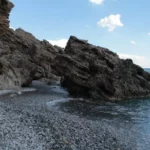
Situated 80km southeast of Chania and just 1.5km west of the renowned Fragokastelo beach, you’ll find the scenic location of Vatalos. Many Fragokastelo hotels and lodging options are found in the Vatalos area, which boasts fertile fields, breathtaking views of the south slopes of the White Mountains, and transforms into a significant wetland during winter. This wetland stretches about 2km to the west, starting from the castle.
Vatalos is dotted with peaceful coves boasting sandy beaches interspersed with pebbles and rocks. From the fortress, you’ll encounter the beaches of Iligas, Hodros Volakas, Mavro Nero, and finally, Vatalos. While most visitors prefer the shallows of the bustling Fragokastelo beach, Vatalos’ beaches provide an idyllic setting for peaceful vacations and snorkelling. Fragokastelo is noted for its medieval castle, the exotic beach, and the legendary Drosoulites ghosts.
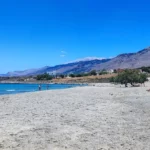
Venturing east from Fylaki beach, a mere 100 meters away, you’ll encounter the terminus of the Sfakiano Gorge, where a beautiful pebbly beach has taken shape. This region, known as Plakakia, is home to some of Crete’s most breathtaking beaches, nestled within slender fjords. In fact, several of these beaches have developed within small caves! A challenging dirt road provides access to the vicinity of the beach.

Filaki beach is located 3 km from the village of Sfakion on the south coast of Crete and 75km south of Chania. If you are staying in Chora Sfakion, it is an easy walk to the beach. Filaki means “Prison”, it was named like this due to its remote location.
It is a pebble beach with rock formations. It is the only official nudist beach on the island. Thanks to the only nudist hotel in Crete in the immediate vicinity, you will meet many like-minded people.
The beach is not wild– Filaki has a well-developed infrastructure: it has a parking lot, water closets, bars, sling chairs, and umbrellas. A more friendly nudist beach cannot be found in Crete.
Crete’s southern treasures offer a diverse range of experiences, catering to a variety of interests.
Historical and Religious Sites: For those fascinated by religious history, the stunning Chrisoskalitissa Monastery is a must-visit. Perched atop a colossal rock, this holy sanctuary offers striking views and a rich historical narrative.
Nature Exploration: If you’re an outdoor enthusiast seeking immersion in nature, the Sfakiano Gorge is an absolute treat. Offering tranquil trails for serene walks, Sfakiano is an oasis of peace and scenic beauty on this idyllic island.
Beach-side Activities: For beach lovers, Filaki Beach holds its own unique charm. It’s not just the azure waters that captivate; the beach also hosts licensed naturist taverns serving delectable local cuisine. Moreover, adrenaline-pumping activities like snorkelling and spearfishing are readily available for thrill-seekers.

The Agios Charalambos cove lies adjacent to a local hotel that caters exclusively to nudists. Situated 1.5km east of Chora Sfakion and 75km south of Chania, it can be found in an area dotted with several nearby pebble beaches. The shoreline comprises 3-4 sequentially isolated coves, with Sfakiano Ammoudi being the first one and Agios Charalambos the following one. A small path through the rocks, before reaching Agios Charalambos, leads to the cave-like church of Saint Charalambos, revered by the Sfakians. Known for protecting people from plagues, Saint Charalambos had chapels built in his name at village entrances. However, in Sfakia, where sea was the primary means of communication, the temple was built along the coast.
The coves, along with the nearby Filaki beach, are primarily occupied by nudists, making them Crete’s only “official” nudist-friendly beaches due to the presence of the nudist hotel. The beaches are pebbly and occasionally exposed to rare southern winds. Their isolated nature means there are no accommodation services, water sports, sunbeds, or lifeguards available. Only the Filaki beach houses a single canteen that can be accessed by car.
To reach the beaches, one can drive from Chora Sfakion or walk, heading east and taking a right turn about 150m after the gas station encountered when leaving Sfakia, towards the Vritomartis hotel. A junction lies just below the hotel. The left (eastern) road leads to Filaki beach, while the right (western) road takes you to the Ammoudi and Agios Charalambos coves.
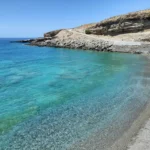
The beach Amoudi is located about 1.5km east of Chora Sfakion and 75km south of Chania, in an area with several adjacent pebbly beaches and very close to the nudists’ hotel Vritomartis. It is one of the many unknown beaches around Chora Sfakion, and one of the nicest. The area, due to conglomerate rocks, is full of small pebbly beaches, such as Agios Charalambos, Filaki and Plakakia.
A rough dirt road, which in the last section becomes quite bad, leads to the beach. Despite its name (ammoudi means sandy beach), Amoudi beach is not sandy but pebbly with crystal clear waters, the cleanest of all the beaches of the area. The seabed is quite remarkable with beautiful formations. Left and right of the beach, the rocks rise forming caves in conglomerate grounds, decorated with caper plants. Caves offer shade on hot summer days.
On the west side above the beach, there is a shrine which overlooks the sea from where the view at Amoudi bay is unique. The most impressive of all, however, is the geological formation called Fokia (Seal). It is a cave on the west edge of the beach, which at its deepest point creates a small beach and has a second outlet to the sea. Because of the two outputs and the easy possibility of escape this cave was used as a nest for sea seals that are still in the area.
On the east side of the beach, there is a path through the rocks leading after five minutes to the cavernous church of Saint Charalambos honoured highly by Sfakians. Next to the chapel, there is the slightly organized beach of Agios Charalambos, not organised. Saint Charalambos was the saint who protected people from the plague, so they used to build chapels dedicated to the Saint at the entrances of villages. But in Sfakia, where the dominant communication with the outside world was based on the sea, they built the temple on the shores. The coves and the nearby beach of Filaki are mainly occupied by nudists, actually being the only “official” nudism-friendly beaches on Crete (due to the nudists’ hotel).
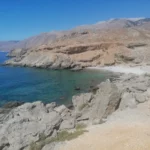
Frangokastello, meaning “Castle of the Franks”, is a renowned beach in Western Crete, steeped in history and folklore due to its age-old Venetian castle and the intriguing legend of the Drosoulites ghosts. This beautiful beach lies in a valley at the foot of the White Mountains, situated 13km east of Hora Sfakion and 80km southeast of Chania.
Fragokastelo’s main beach is an appealing spectacle with its sandy shoreline and shallow turquoise waters, a perfect setting for children and families. Despite being well-equipped with amenities and buzzing during the summer months, the beach is sometimes subject to bothersome northern winds that sweep the sand. However, the area boasts plenty of accommodations, dining options, shops, and an ATM, with the nearest hospital located in Sfakia.
To the west of the main beach, the expansive Vatalos beach and a significant wetland (in winter) offer a different experience, with a mix of sand, pebbles, and rocks perfect for snorkelling. A short 300m walk to the east from the main beach leads you to the breathtaking Orthi Ammos beach, renowned for its sand dunes.
Accessing Fragokastelo from Crete’s northern coast requires a drive along the National Road connecting Chania and Heraklion, exiting at Vrysses and following the road to Chora Sfakion (Sfakia). This route takes you across the Askyfou plateau and through the stunning Imbros Gorge to the southern coast of the Sfakia province. Fragokastelo is well-signposted from here, and the journey typically takes around 1 hour and 20 minutes. If you’re coming from Rethymnon, take the road to Plakias, then head east to Rodakino before reaching Fragokastelo. This drive is around one hour and provides a less challenging but also less scenic route than through the Imbros Gorge. Alternatively, buses to Fragokastelo are available from Chania.
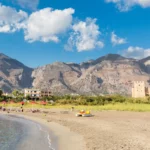
Sfakia, also known as Chora Sfakíon, is a quaint town located on the southern coast of Chania. This town, nestled near the end of the Sfakiano Gorge and 74km south of Chania city, serves as the capital of the isolated and mountainous region of Sfakia.
Vrissi, the primary beach of Chora Sfakion, can be found at the town’s western end. This appealing pebbly beach is well-maintained and conveniently close to the town’s facilities. You can stroll down the narrow lanes of the village to reach the beach. Overlooking the eastern end of the beach is the ancient Byzantine church of Saint George, locally known as Agios Georgios.
Adjacent to the quaint harbour of Sfakia, locally referred to as Limani or Ombrosgialos, is another beach. Although smaller and less attractive than Vrissi, it is well-arranged and situated in front of the local tavernas. This harbour is the departure point for the ferry service to Agia Roumeli, Loutro, Sougia, Gavdos island, and Paleochora. A memorial above the beach pays tribute to the final Australian, British, and New Zealand forces who were evacuated from this bay by British and Australian warships between 28th May and 1st June 1941, after the intense Battle of Crete.

Orthi Ammos is a stunning sandy, shallow beach located next to Frangokastelo, 80km south of Chania, on the edge of a large valley with a warm climate. It has seen modest development compared to the neighboring tourist hotspot of Frangokastelo.
The beach is known for its vast sand hills and dunes, as well as its crystal-clear waters. Although it is affected by southern winds, the impact is mild. The eastern section of the beach has traditionally been a spot for nudists, though their numbers have dwindled in recent years. The beach can be reached by a 10-minute walk from Frangokastelo or by parking above the sand hills. But beware, the sand can get very hot on the descent to the beach!
Compared to adjacent Frangokastelo, Orthi Ammos is a peaceful beach. However, it offers limited accommodations and food amenities, without any sunbeds or water sports services. Its easternmost part, known as Kritama, is marked by high cliffs and turquoise water.
Legend has it that the sand of Orthi Ammos hid the unburied bodies of the 335 Greek heroes who fought against the Turks in the Battle of Frangokastelo on 17 May 1828. These heroes’ spirits are known as the Drosoulites, the famed “ghosts” of Fort Frangokastelo.

No results available
Reset© All rights reserved. Crete Locals